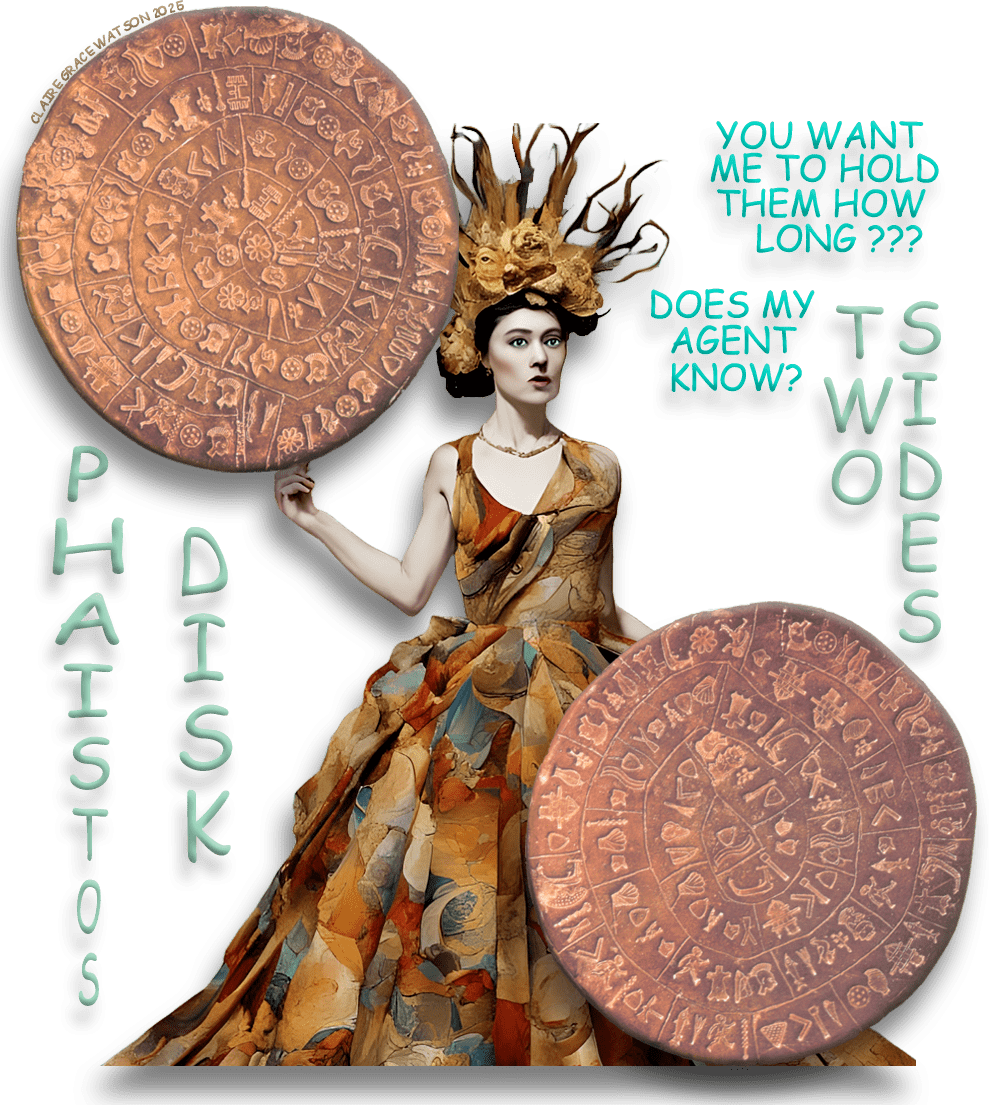
This world-renowned enigma comes from Minoan Crete, about 1600 BCE, the ancient civilization famous for naming our constellations and for the Maze of Daedalus. Though the Disk seems chaotic at first, Mediterranean Bronze Age concepts of mathematical symmetry can be identified just by counting the pictographs, the spirals, and the line segments. In time, from out of that close study of seeming Chaos comes a revelation of the highest Order.
The artifact is terracotta pottery, about 6" in diameter and 1" thick, only a little larger than a CD, with 2 inscribed sides and 2 spirals per side, each spiral with 5 rings (10). The spirals are divided into 60 line segments (30 Side 1, 30 Side 2). The outside spirals have 12 line segments (24 outside); inside spirals have 18 (36 inside). Divided among the line segments and etched into the disk are 48 unique miniature pictographs, the same number as our ancient constellations, and most of them are replicated to create 240 pictographs. 37 are created to appear identical and are repeated various times. 11 are unrepeated.
All the theories I've ever read regarding the Phaistos Disk are either opportunistic in nature, with the theorists hoping to draw attention to themselves, or they express ownership of the artifact (archaeology) while insisting it remain unknowable (Archaeological Museum of Crete). All of them vastly underestimate the intelligence and creativity of these Bronze Age people.
Just because the Disk comes from the Mediterranean Bronze Age and is at least 3,600 years old does not make it invitational to simply start wild-guessing about what it is, or to claim ownership over what the understanding of it ultimately will be. Both of these approaches disrespect the pottery artist who created this masterpiece and the civilization from which it emerged.
It definitely was created to preserve something of importence because it was fire-hardened in a world of sun-baked pottery and it was painstakenly and rapidly etched with 240 pictographs so tiny they appear to be identical rather than just matching. In fact, when I first found the Phaistos Disk in books, all of them declared outright that a printing press was involved. "Had to be," they all said, "because how else could it have been done?" But on close study of the pictographs, not a single one of them is identical. So what is this artifact about?
"This is a poem." "No, it's a prayer." "It's a magic spell." "This is a healing ritual inscription." "Or it's a court list." "Or it could be a musical notation." "This is Crete's enigma and shall remain unknowable, at least until we can ascertain what effect on revenue a change might have." "This is a hymn to the mother goddess. akka akka akka" "It's a gaming board." "This belongs to archaeology. We found it, it's ours and we will handle any and all decipherments of it." "It's a curse!" "It was left behind by UFO's."
I, too, have a theory, but for my own theory to hold true these ancient people would need to have been highly intelligent, incredibly creative, curious and analytical as regards the universe. Further, they would need to have been preceded by people much more ancient than themselves who also held these attributes. I come to this conclusion only because the Phaistos Disk is evidence of it and because it occurred to me one day to overlap the two sides at what appear to be matching line segments.
When I saw the wave spiral produced by the overlap, I knew a very creative person had invented something remarkable and, quite possibly, beyond our grasp. I wondered if the name of the artist/inventor was Daedalus. After thirty years of studying this ancient artifact, which involves mountains of research and a continuous deep dive into the consciousness of people in a lost world, here is where my theory begins.
I believe this Bronze Age pottery art masterpiece is a minature of the universe - a Disk of the World - that also preserves an inventive and logical math proof that the universe is a math structure, in fact a math maze, comprehensible through the integrated sciences of 4,000 years ago - Mathematics - Geometry - Astronomy - and shows the beginning of serious, scientific investigation into the universe. It is the basis of the knowledge platform upon which the Greek mathematician and mystic Pythagorus stood, 1,100 years after the artifact was created, to share with the world his understanding of the correlation of mathematics with metaphysics. Strengthened by Pythagoras, this same ancient platform gave support centuries later to the noted Greek philosophers Plutarch and Plotinus.
1 2 3 5 4 4 5 3 2 1
The solution to the Phaistos Disk, a maze puzzle from our perspective, offers a Mediterranean Bronze Age math proof of infinity, both graphically and mathematically, in the form of a numerical palindrome - 1235445321 - which, reading front to back and back to front, uses numbers to prove infinity or endlessness. In a demonstration of the Minoan mathematicians' (or at least this pottery artist's) understanding of paradox is the use of something finite, a line segment, to prove infinity, as a line can be divided infinitely.
Further, the math proof of infinity can be verified by the math function of natural addition of the crossover section of the numerical palindrome. 3+5+4+4+5+3 = 24 divided by 2 =12 (a division function, the total number of line segments on the outside spirals) multipled by 2 (a multiplication function, the number of sides) = 48 (a sum function, the total number of unique pictographs and constellations). Also, the entire palindrome 1+2+3+5+4+4+5+3+2+1 = 30 (the total number of line segments on each side of the Disk) x 2 (the number of sides) = 60 (the total number of line segments both sides of the Disk).
And in these sixty spaces dwell the souls, each one according to its nature, for though they are of one and the same substance, they are not of the same dignity. (Plutarch)
This nearly-lost, antique, math-based mythology is preserved by Plotinus, philosopher founder of Neoplatonism, and Plutarch, philosopher priest at the Temple of Apollo at Delphi, and the Phaistos Disk of Minoan Crete. Plotinus (1,300 years after the Phaistos Disk) and Plutarch (1,500 years after the Phaistos Disk) both give accounts of an ancient worldview involving a numerological outlook passed down from Crete.
This outlook involves the number-based origin of both the universe and humanity. Formed in the womb of the Minoan creation goddess, Rhea (Chaos), were 5 cosmoi (main divisions or layers of cosmic stuff, the 5 spirals each side of the Disk), and into these layers or firmaments formed 60 soul spaces (total number of line segments on the Disk) made of 60 types of soul-stuff, comprising 240 individual souls (total number of pictographs on the Disk) made of 48 "ark types" (ships of the sky or constellations and total number of unique pictographs on the Disk).
This is the Minoan math argument for both a mathematically constructed universe and for the divine nature of humanity, carefully preserved on the Phaistos Disk. Also passively preserved is why an artist would go to such lengths to create this artifact. The math proof would need to be preserved for subsequent generations so they would not get so lost in the maze of the material world that they lose all knowledge of their mathematically proven, and thus divine, origin.
The creation of the Phaistos Disk was not an attempt to create and preserve for posterity a masterpiece of art, although that is what happened en passant, but was an attempt to save mathematics from getting lost to the world. This would ensure that the generations to follow would have both the equipment necessary to navigate Chaos and to understand its divine function of giving birth to the world - to Order. The effort turns out to have been both unnecessary and necessary, as Pythagoras, Plutarch, and Plotinus got the knowledge anyway and broadcast it, but lost in time was the awareness of the importance of Minoan Crete in its development.
To solve the maze, and experience the palindrome, overlap Side 1 onto Side 2 (red spiral on top of purple spiral) at the matching, connecting line segments. Next, start at the center of Side 1, then move counterclockwise. Cross over from Spiral 3, Side 1, to Spiral 5, Side 2 (green bug), and move clockwise. Cross over from Spiral 5, Side 2, to Spiral 4, Side 1 (pink bug) and move counterclockwise. Cross over from Spiral 4, Side 1, to Spiral 4, Side 2 (purple bug), move clockwise. Cross over from Spiral 4, Side 2, to Spiral 5, Side 1 (yellow bug), move counterclockwise. Cross over from Spiral 5, Side 1, to Spiral 3, Side 2 (orange bug), move clockwise and travel to the center of Side 2, creating the shape of a figure 8, twice. Return in the same pattern. (1, 2, 3 into 5, 5 into 4, 4 into 4, 4 into 5, 5 into 3, 2, 1)
The maze puzzle has been solved, the numerical palindrome math proof of infinity established, and the basics of the phi spiral revealed - certainly worth preserving for posterity in fire-hardened terracotta.
But it isn't just the mathematics that stands out in the math proof, but also the art. The Phaistos Disk puts the art in artifact as it creatively delivers complex information in a simple way, based on the Minoan love of mazes and their creation of
our 48 original constellations by connecting stars with lines. And, it makes use of an invisible dimension to continue its revelations about the Minoan world via large, hidden pictographs. The hidden dimension, arguably its main revelation and certainly its most surprising one, begins on Page 3, while Page 2 continues this investigation into the Figure 8 design of the Disk of the World, as shown above on this page, and also explores its history.
The history surrounding the Phaistos Disk and its discovery is fascinating. The two-sided
terracotta disk from the Mediterranean Bronze Age was found in 1908 beneath the burned-down Phaistos Palace, Crete, in a basement corner accessible by a trap door above. Beside the disk was a tablet of Linear A writing (undeciphered) of ancient Crete, likely explaining it. Fire-hardened,
perhaps by the fire, the Disk is an anomaly in a Minoan world of sun-baked
pottery. One of archaeology's greatest mysteries, it is, like the universe, a
masterpiece of concealment. When we are right in the heart of it we see
chaos, but that only conceals the patterns. From out of this ancient world, from the same time and the same place, comes the other renown mystery, the Maze of Daedalus. Are the Phaistos Disk and the Maze of Daedalus the same thing? In the Phaistos Disk, we have the artifact but not the narrative, and in the Maze of Daedalus, we have the narrative but not the artifact. They fit together like interlocking puzzle pieces.
The Daedalus myth, from Greek mythology that began in the Minoan
civilization, involves the Shell Riddle. At the urging of his wife, King Minos of Crete went searching
for Daedalus, the renown inventor and favorite of Queen Pasiphae. The inventor was wandering the world in grief, and the king and queen were much concerned. A tragedy had occurred.
Daedalus had invented remarkable wings fashioned of feathers and wax and designed to give flight to whomever wore them. While he was busy working on a project for the queen, his son Icarus put on the wings and flew too close to the sun. When the wax melted he crashed and died.
Daedalus, in his grief, blamed himself and wandered the Aegean world mourning the loss of his son. After burying Icarus, Daedalus traveled to Camicus in Sicily, where he stayed as a guest under the protection of King Cocalus. (Wikipedia)
As King Minos searched for Daedalus he carried with him a seashell puzzle, called the Shell Riddle, and asked everyone he met to solve it. He knew that only Daedalus could solve the riddle, and this was how he meant to identify him since he might be much changed in appearance.
Minos, meanwhile, searched for Daedalus by traveling from city to city asking a riddle. He presented a spiral seashell and asked for a string to be run through it. When he reached Camicus, King Cocalus, knowing Daedalus would be able to solve the riddle, accepted the shell and gave it to Daedalus. Daedalus tied the string to an ant which, lured by a drop of honey at one end, walked through the seashell stringing it all the way through.
The Phaistos Disk is the spiral seashell, and the spirals of the
Disk are the string running through. The string becomes more famously known as Ariadne's Thread
in a late Bronze Age fiction written by Plutarch based on the Shell Riddle, and involving Theseus, a Minotaur, and a maze. The
riddle in all cases is how to get all the way through the seashell to find the honey, or through
the maze to escape the Minotaur, or through the Disk to solve the maze.
The solution to a maze puzzle is the uninterrupted path through a series of intricate line segments from a starting point to a goal. This maze puzzle, the Shell Riddle, is not solved until the outside spirals of the seashell are part of the uninterrupted path from the center of Side 1 (flower/sun) to the center of Side 2 (honey pot/star.) Only if the ants can easily travel in a straightforward manner on the outside spirals (edges of the Disk) to find the Honey Pot is the Shell Riddle solved.
Solve the Riddle
Nearly lost with the Disk is the antique science etched upon it, conceived of in a world so long ago that science and religion were mixed together in such a way as to render the universe a sacred conception, with purpose in existing and deliberate design, rather than a random explosion with no reason to be except chance.
The Phaistos Disk seems to be covered with hidden patterns of this geometry theology and number philosophy that preserves the science that built the Great Pyramid and that became the foundation of Western Science and Religion. This is the mostly forgotten and nearly lost antique science of Containment of Geometrical Arrangements. This "earthly" science was extended to early astronomy which involved the study of the properties of a circle (containment) and the geometry of a sphere (geometrical arrangements), for use in astronomy.
The circle/sphere of containment is the Phaistos Disk and the geometrical arrangements are the hidden pictographs created by connecting matching pictographs with lines, as in created constellations in astronomy. The Phaistos Disk is demonstrating the relationship of geometry with astronomy to show the sameness of the two sciences. Aligned this way, and used to diagram and interpret both earth and sky, these sciences together can produce an offspring, a kind of power that is Metaphysics, capable of occupying the mind of a savant like Pythagoras. This philosophy, transcendent of geometry, astronomy, and mathematics, engaged Pythagoras for the entirety of his life and created him as a mystic. It lead Plotinus to found Neoplatonism and it encouraged Plutarch to reside as a priest at Delphi, the name reminiscent of both Phaistos and Phi spiral.
In summary, the continued solution to this world-famous enigma involves using geometry to connect with lines the matching pictographs to produce hidden, larger pictographs, as in stars connected with lines to produce constellations. Because the pictographs are so tiny, they appear to be identical and can be isolated to demonstrate this Mediterranean Bronze Age science.
Invisible Dimension, Revealed by Connecting Matching Pictographs Through the use of this antique science, the disk delivers complex information in a simple way. Based on the Minoan love of mazes and the ancient method of forming constellations by connecting stars with lines, the disk conceals the constellation Argo and other related images that are revealed when matching pictographs are connected by lines.
Images above from left to right: Constellation Argo, Star Sirius and Seven Planets, Great Pyramid Exterior, Great Pyramid Interior, Great Pyramid - Apex, Base, and Two Sides, Great Pyramid Warrior Perimeter, Right Triangle, Diameter
Euclidean Geometry is on the Phaistos Disk 1,300 years before the Greek mathematician and geometer Euclid. Where did Euclid get his plane geometry for which he is so famous if not from this Mediterranean Bronze Age science?
It does become evident via the Phaistos Disk that the Minoans had intimate knowledge of the Great Pyramid - the outside, the inside, from above, from below, from the side. Evidencing their knowledge of the Egyptian concept of Duat, they also knew of its existence high above in the stars as the sails of the constellation Argo.
Philosophy [nature] is written in that great book which ever is before our eyes -- I mean the universe -- but we cannot understand it if we do not first learn the language and grasp the symbols in which it is written. The book is written in mathematical language, and the symbols are triangles, circles and other geometrical figures, without whose help it is impossible to comprehend a single word of it; without which one wanders in vain through a dark labyrinth. (Galileo)
48 unique pictographs are distributed in the spirals in a seeming random way over both sides of the disk for 240 impressions. When all the matching pictographs are connected to themselves, every piece of Euclidean geometry emerges, 1,300 years before Euclid lived. Revealed are diameter, right triangle, cone, every kind of triangle, rectangles, polygons, parallel lines of same length and different length, and significant, large images of the Great Pyramid, inside and out, from below, from above and from the side, an image of the constellation Argo, an image of a spiral maze with a triangle at the center, an image of a big star inside a heptagram - maybe it is the star Sirius inside the seven planets, maybe it's the heliacal rising of Sirius, maybe it's the ancient symbol for astronomy, or maybe it's all of these! Did the Minoans have a geometry philosophy called Planeism?
Bronze Age geometry theology may have passed from Minoan Crete into mysticism to eventually became known as Sacred Geometry.
...in those days [of ancient Egypt] of initiate kings and rulers and sages who occupied themselves with the Sacred Science,
when the clear Aether spake face to face with them without disguise, or holding back aught, in answer to their deep scrutiny of holy things. It is easy to see how a visionary artist familiar with this ancient science could envision the creation of a disk with other familiar forms - the boat, the star, the pyramid - and not just the natural geometrical arrangements (geometry) that would occur by connecting with lines the matching distributed pictographs on the disk. None of the pictographs are randomly placed on the Phaistos Disk. If the glyphs were hieroglyphs, as so many linguists are hoping for, then the ability to communicate additional pictographs would be lost because the glyphs would need to form sentences and could not therefore be precisely placed to form images.
Information about this ancient world would be completely lost in time because, in order to recall it, we would need to be able to speak or decipher the script. If we could not, then all would be lost. But a simple method of connecting familiar pictographs with lines would leave us able to comprehend their world because we would be able to see and understand the pictures without having to know the dead language, the idea being that geometry is universal, the stars are eternal, and the Great Pyramid is permanent. This Phaistos Disk method of transmitting information is brilliant.
A pictograph is an ideogram, conveying its meaning through what it resembles, unlike hieroglyphs that tell a story using alphabetic composition. Where hieroglyphs gain meaning by successive placement of the glyphs and represent words, pictographs gain meaning by selective grouping of the signs and convey ideas by what they resemble. Where script is a language that can be deciphered and read involving speech sounds, a pictograph is a symbol complete within itself representing an object or an idea.
These disk pictographs, for example, are what they seem to resemble; a pig, ?, an axe, water, ?, a fish, and a crab. What other meanings can they have? Grouped together this way they seem to be ideograms representing parts of a wide-spread ancient Egyptian mythology well-known to the Minoans and the Aegean world - the Isis-Osiris mythology. In this set, when Osiris's evil brother Typhon was out hunting pigs, he found the body of Osiris, that he had originally tossed into the Nile inside a coffin-chest, and chopped it into pieces with his axe, then threw it into the Nile River where one of the pieces, the phallus, was eaten by the sharp-snout fish and the Nile crab.
In the case of the Phaistos Disk the locations of the pictographs are specific placeholders to anchor images and/or geometries that create even larger pictographs conveying even larger ideas. In this respect, the Phaistos Disk displays an advanced, well-thought-out system of picture writing.
Picture writing potentially can convey much more information about a civilization than a script can because it shows both the archetypal or universally understood elements of any civilization and also the elements of a specific civilization. Picture writing speaks to everyone, and this makes it a better method of communication than script for many reasons. Script is abstract and has to be learned, making script writing a part of the social, financial and political fabric of a civilization.
Not everyone can understand script, but everyone can interpret picture writing. When one of the pictographs is deciphered or identified, then something about the civilization is deciphered or identified, and from this can come much information about the people, about how they lived, what they believed in, and how they expressed it. Arrange the pictographs differently and they mean something different. Place them in certain geometrical arrangements and, again, the meaning changes. Although the Phaistos Disk does not display a hieroglyphic narrative, this Bronze Age, pottery art masterpiece might record an ancient mythology, story or event by use of the narrative technique "continuous representation," the depiction of successive incidents or scenes within a single composition by artists telling a story with their art. It began in Mesopotamia and was fully developed in Minoan Crete in their mosaics.
The disk seems to be a fantastic example of continuous representation in art but instead of several successive scenes as in the Maze of Daedalus
there are successive pictographs or ideograms. In some instances, groups of pictographs and even line segments are exactly repeated or continuously represented, indicating a careful selection on the part of the artist(s) in using certain pictographs to anchor certain images and geometries in order to create continuous representation. This would afford additional meaning for this brilliant picture writing language. These line sequences are repeated - continously represented - on the Phaistos Disk.
Narrative art is art that tells a story, either as a moment in an ongoing story or as a sequence of events unfolding over time. Some of the earliest evidence of human art suggests that people told stories with pictures. However, without some knowledge of the story being told it is very hard to read ancient pictures because they are not organized in a systematic way like words on a page, but rather can unfold in many different directions at once. More on picture writing see: Fantasy Interview with Sir Arthur Evans Before we continue, a caution from Will Durant, which I read early on in my research that I began over 30 years ago and which I took seriously.
![]()
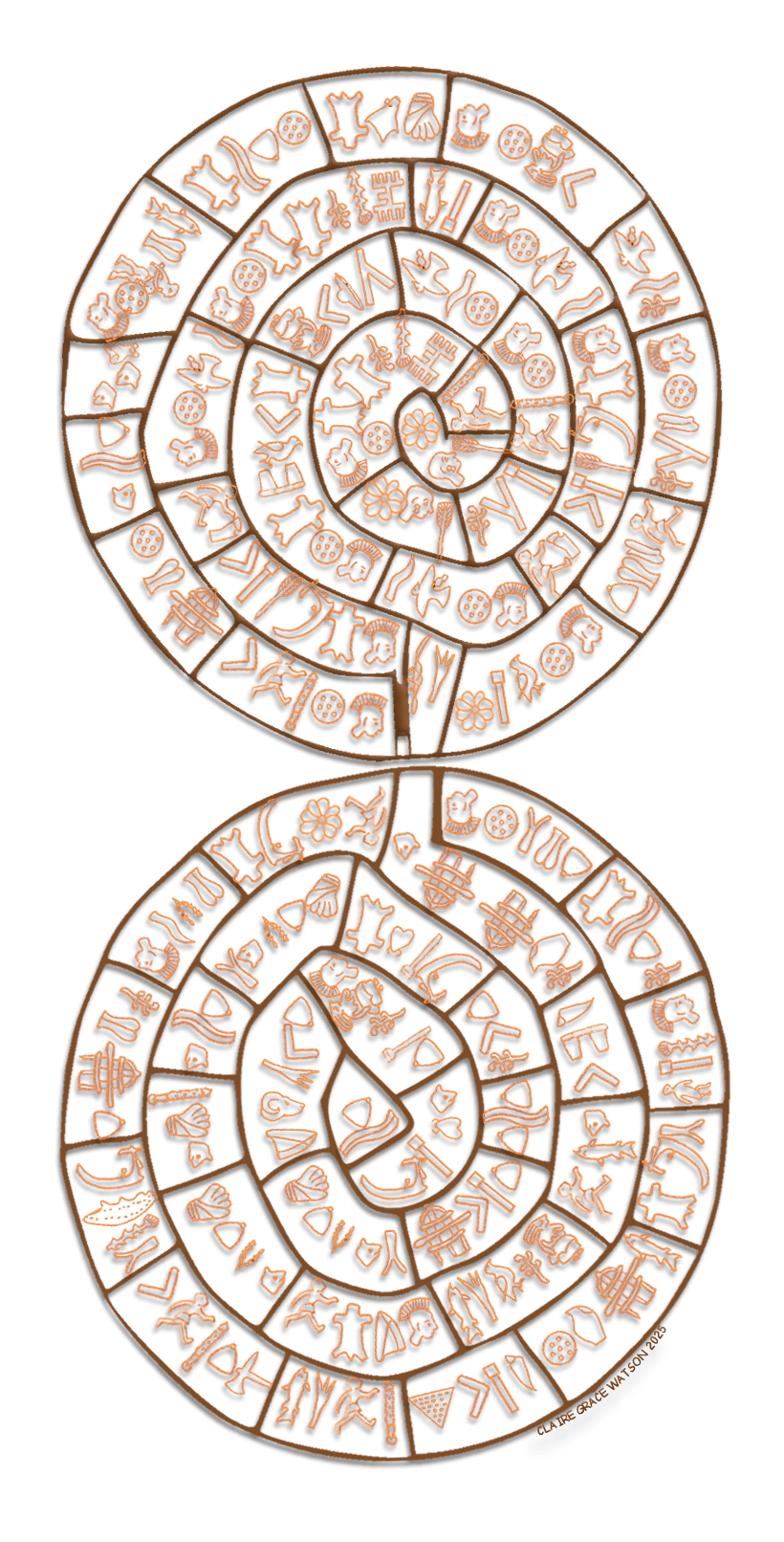 Phaistos Disk, Side 1 and 2 - pictographs and spirals traced, background removedDiverse Theories My Theory - Part 1 Phaistos Disk Math Proof of Infinity
Phaistos Disk, Side 1 and 2 - pictographs and spirals traced, background removedDiverse Theories My Theory - Part 1 Phaistos Disk Math Proof of Infinity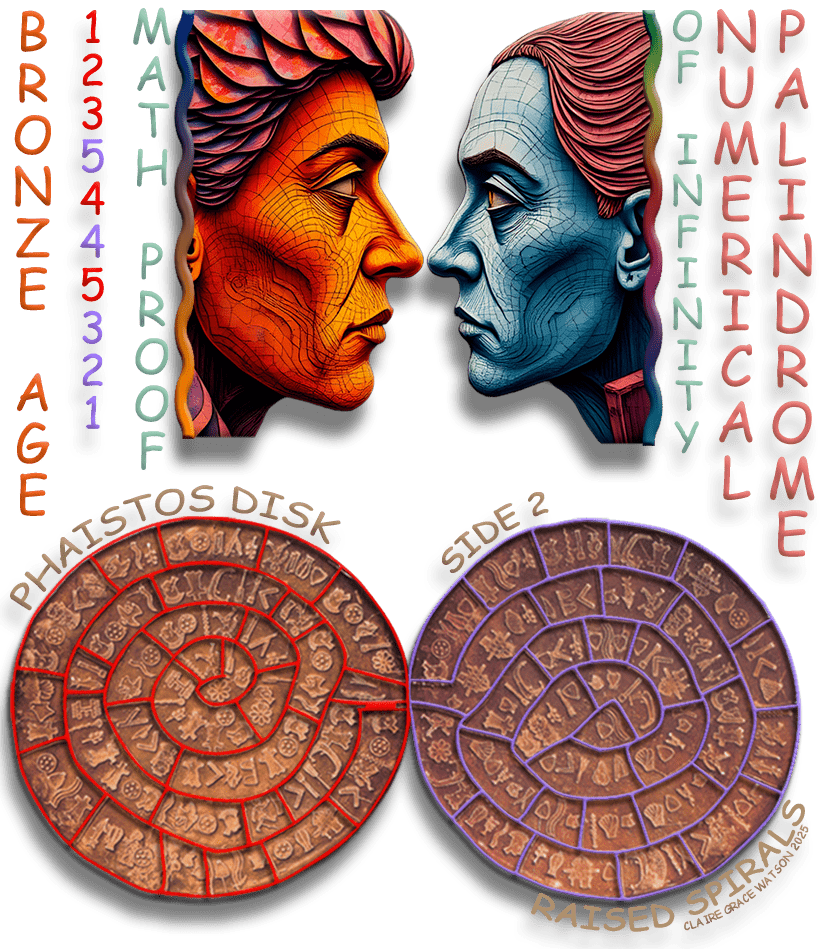
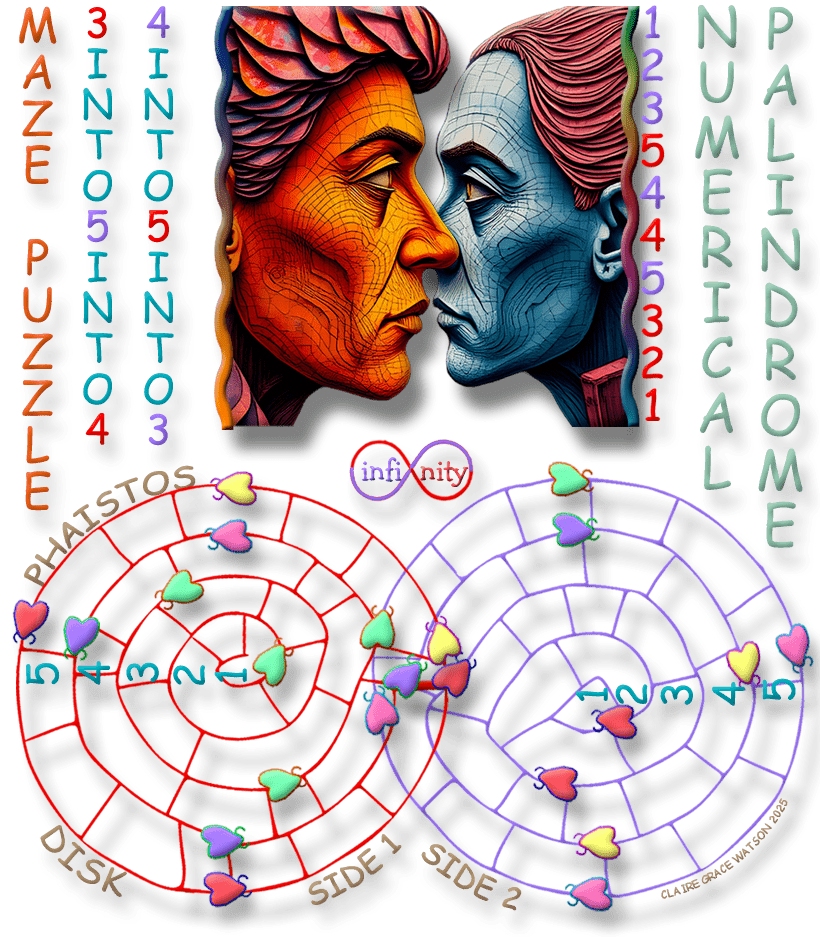 Follow the Math Proof
Follow the Math Proof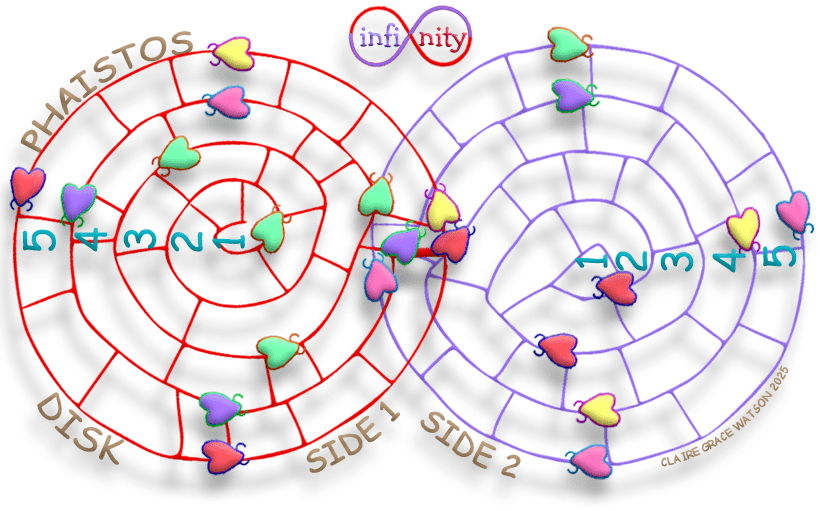 Phaistos Disk Maze of Daedalus
Phaistos Disk Maze of Daedalus
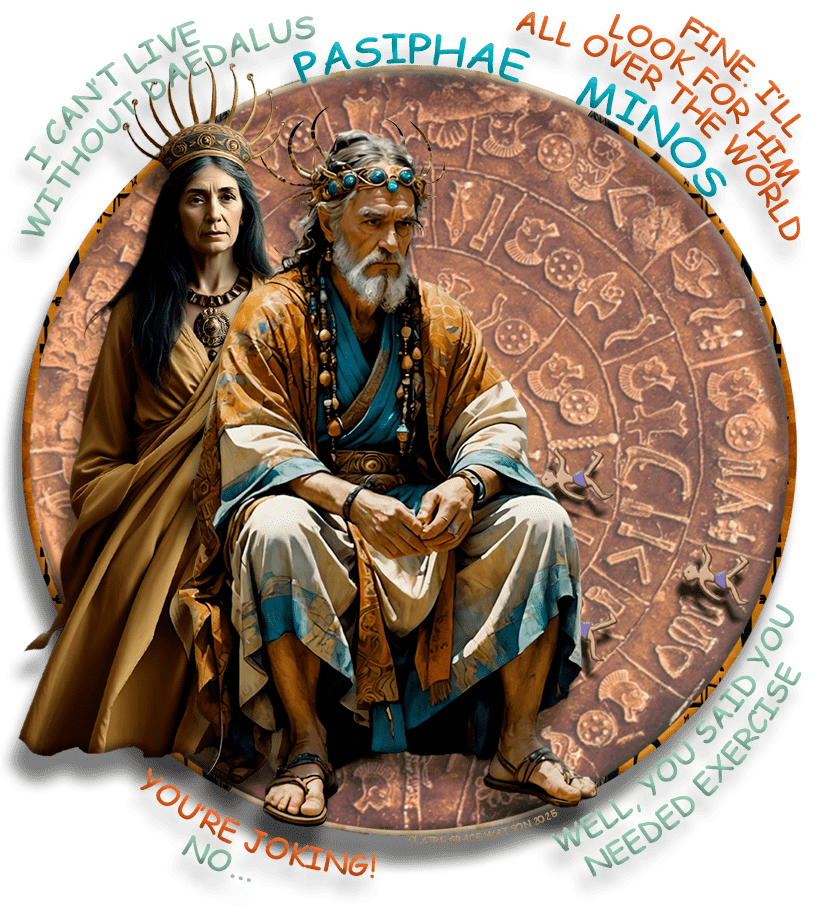
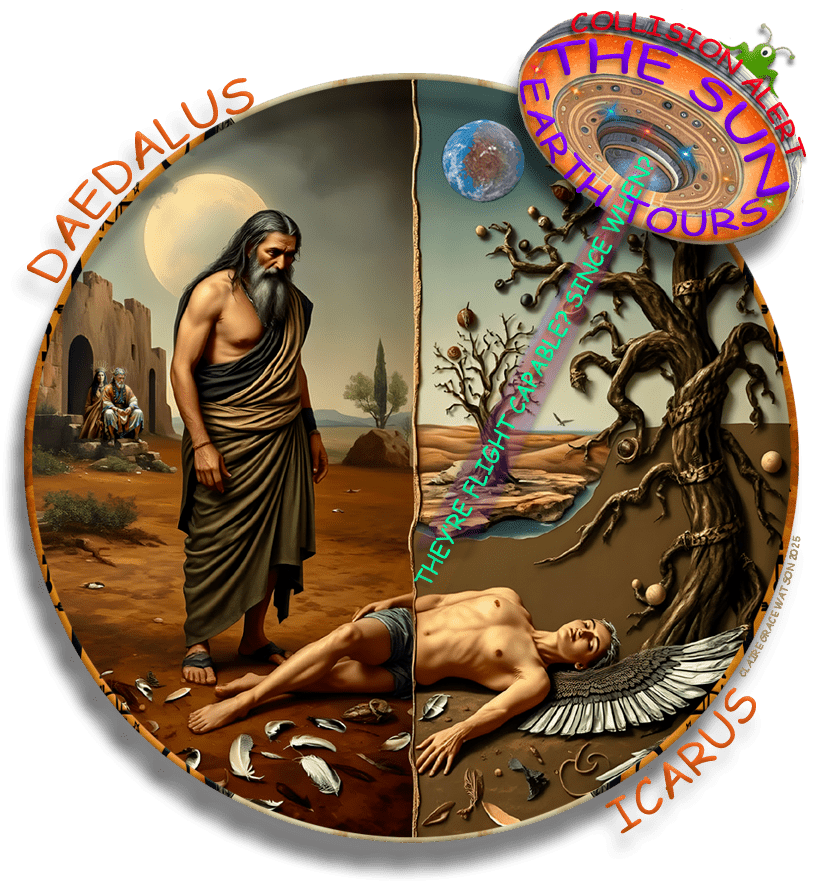
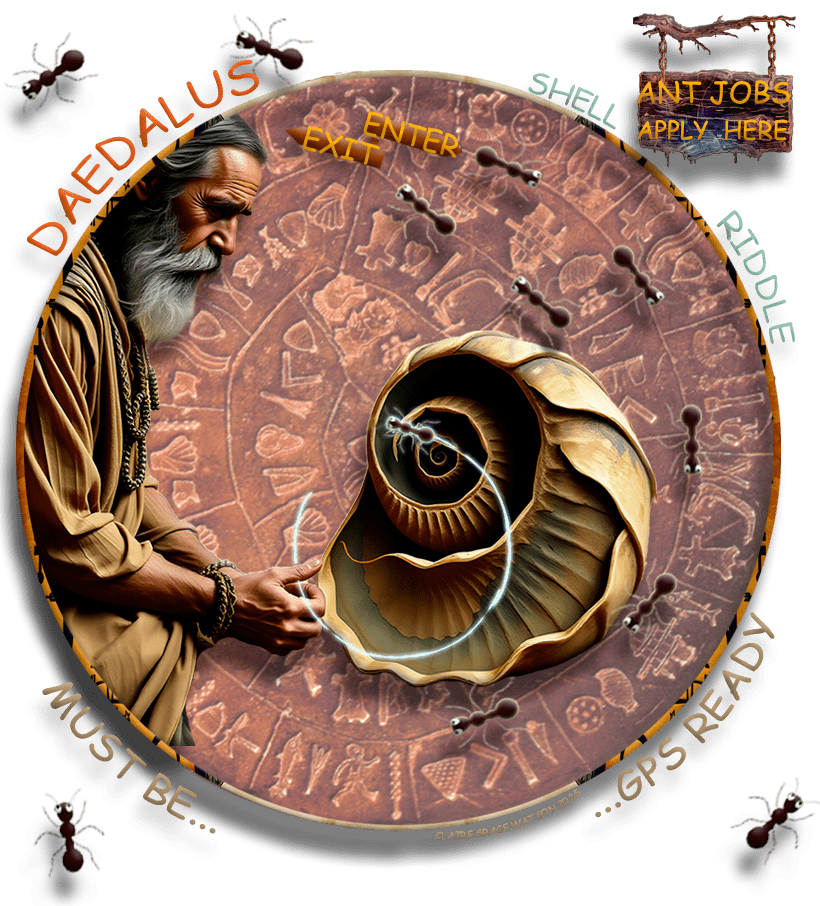
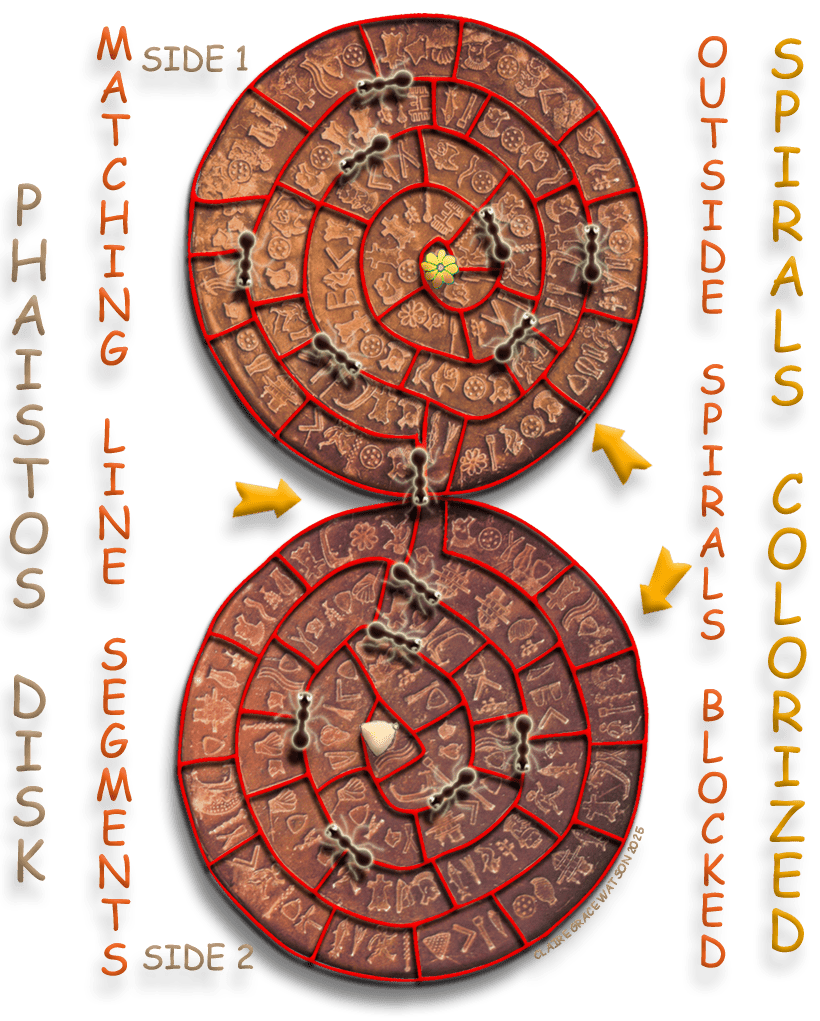
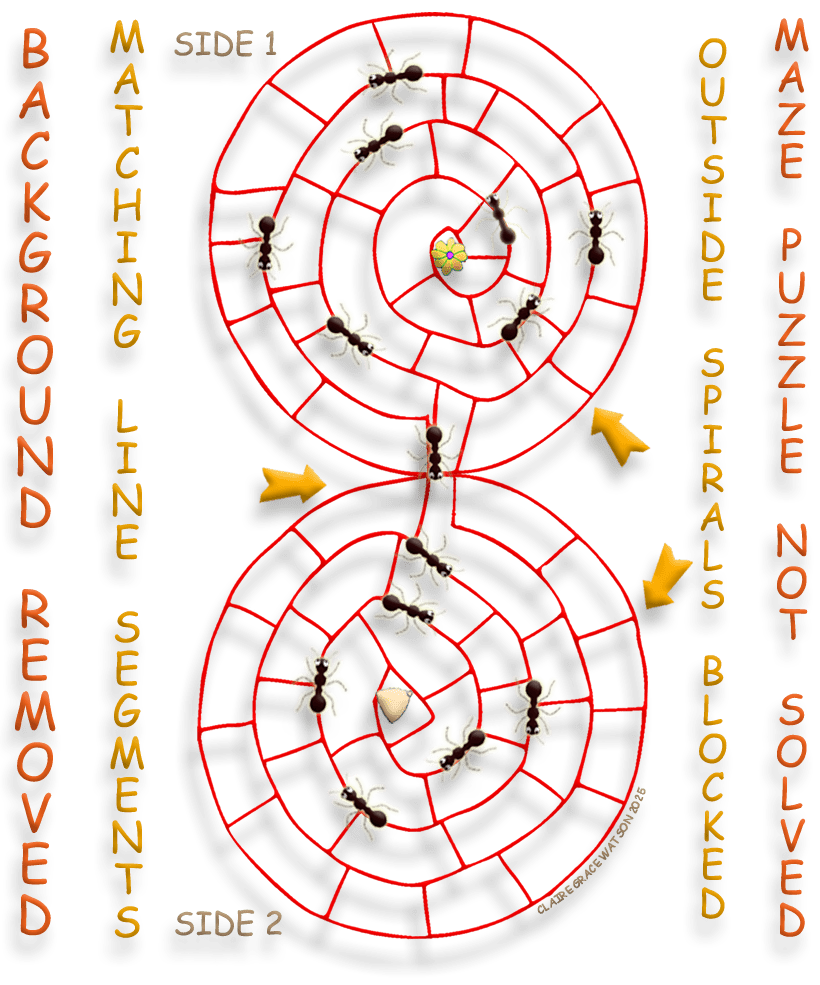
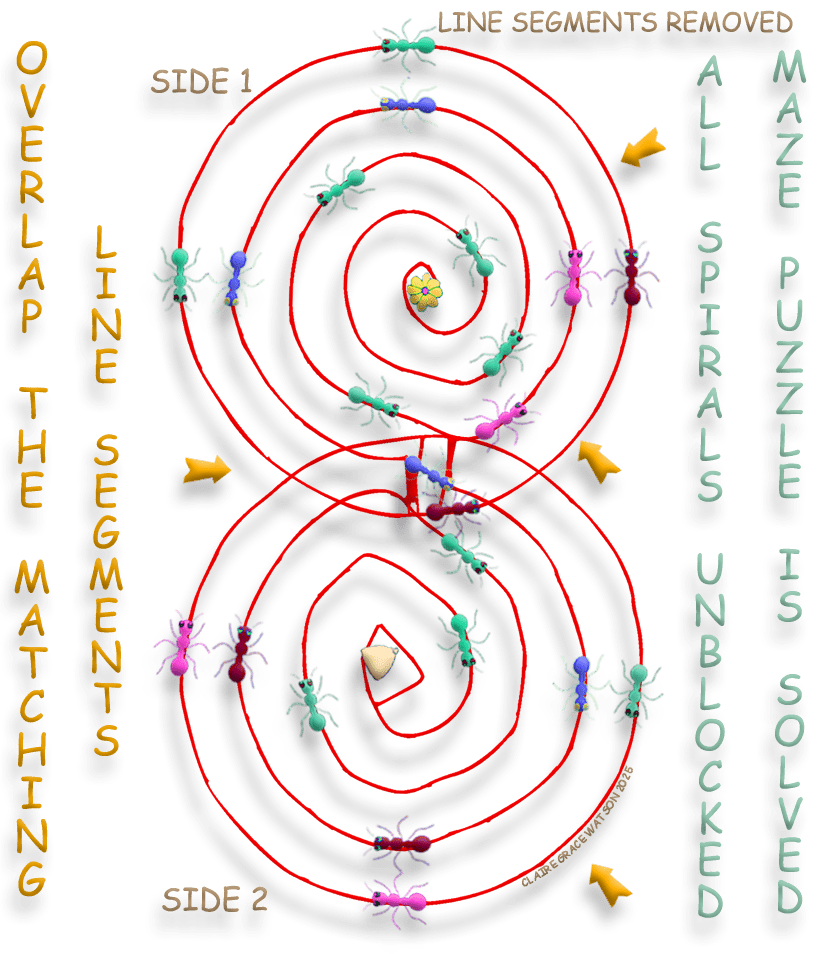
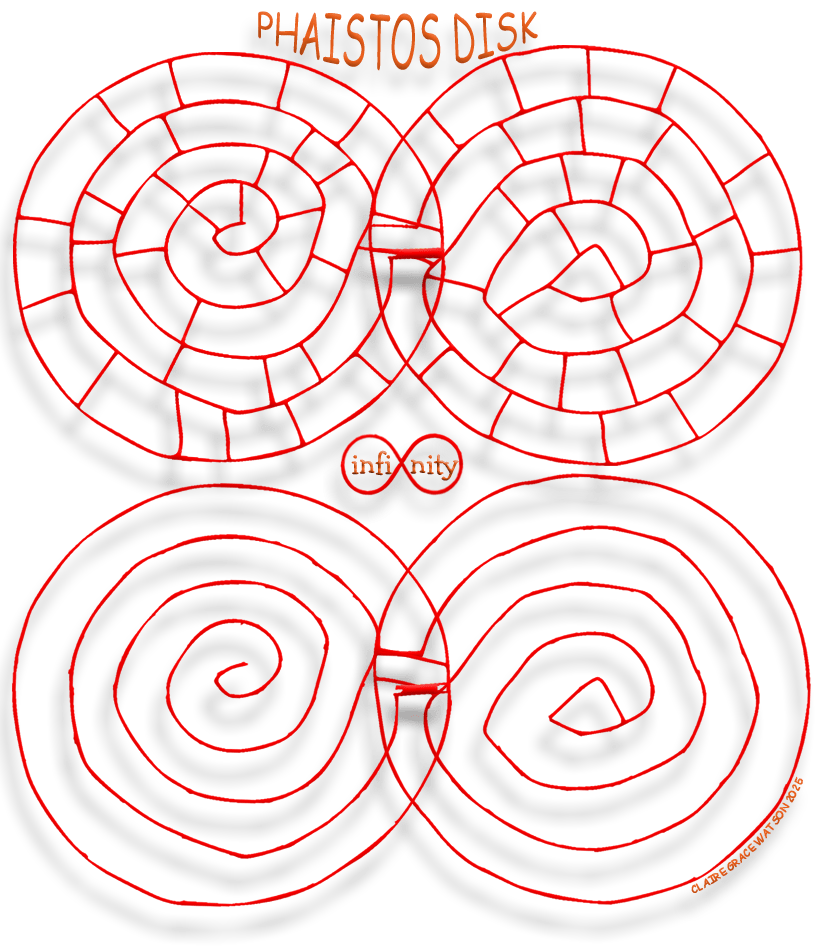 Mediterranean Bronze Age Antique Science
Mediterranean Bronze Age Antique Science
Containment of Geometrical ArrangementsMy Theory - Part 2
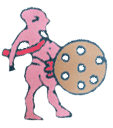 Taking a clue from this unique, unrepeated pictograph (left, man holding a shield with seven tiny circles in the shape of a hexagram), the connect-the-dots approach of viewing the disk reveals, besides the numerous and common (to us) plane geometries expected to be seen, in total eight significant and complex images or larger pictographs concealed on the disk, that exact number foretold by the Figure 8 design, again forming a symmetry. This complex geometry is highlighted here, accomplished by removing the disk background and unused pictographs so only the matching ones remain, with the spiral faded into background. By this method is the invisible dimension revealed, populated with larger, more significant pictographs.
Taking a clue from this unique, unrepeated pictograph (left, man holding a shield with seven tiny circles in the shape of a hexagram), the connect-the-dots approach of viewing the disk reveals, besides the numerous and common (to us) plane geometries expected to be seen, in total eight significant and complex images or larger pictographs concealed on the disk, that exact number foretold by the Figure 8 design, again forming a symmetry. This complex geometry is highlighted here, accomplished by removing the disk background and unused pictographs so only the matching ones remain, with the spiral faded into background. By this method is the invisible dimension revealed, populated with larger, more significant pictographs.
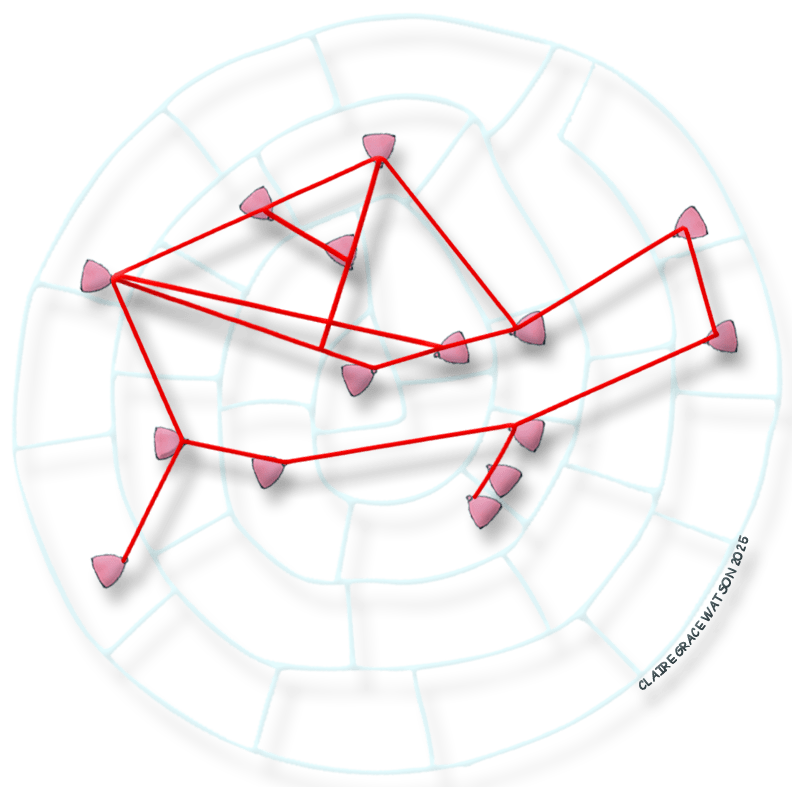
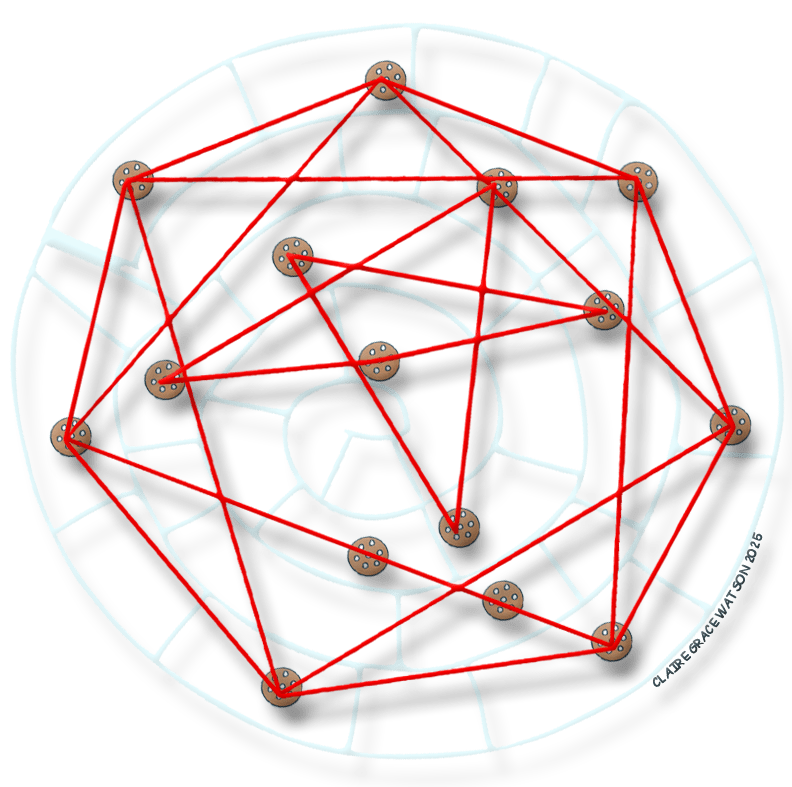
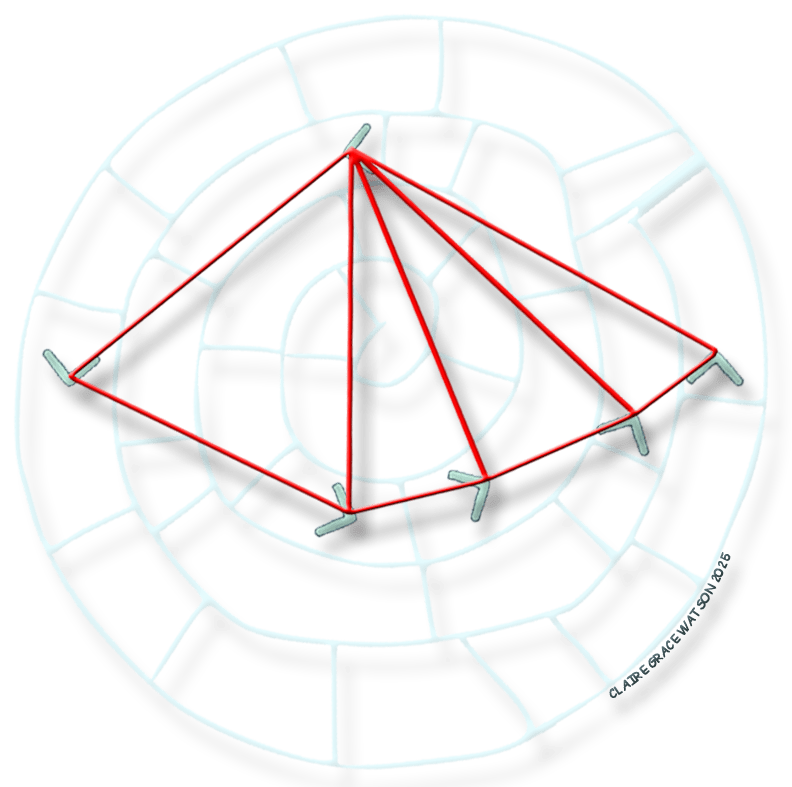
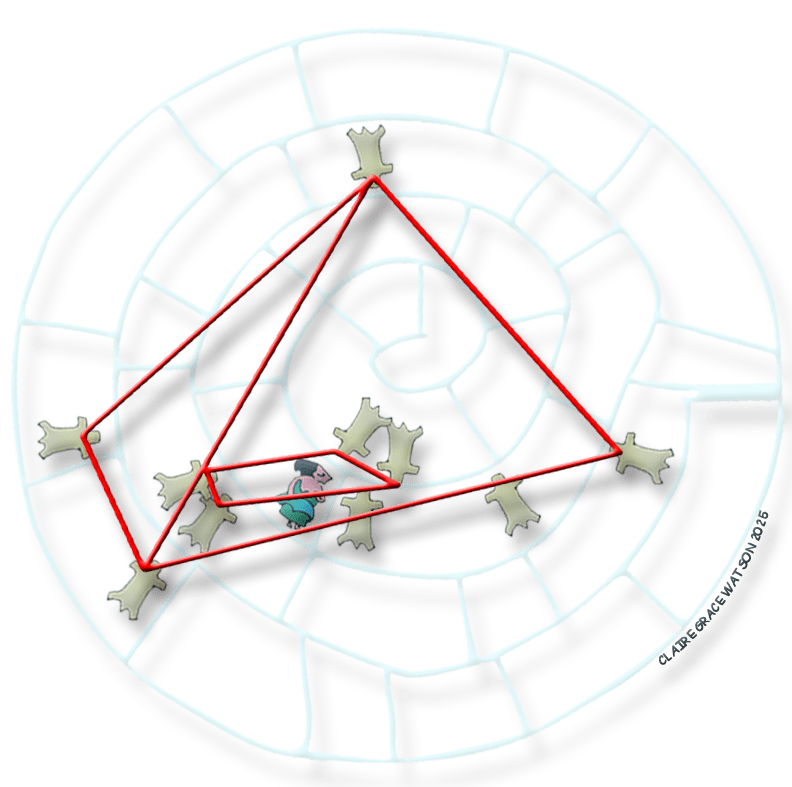
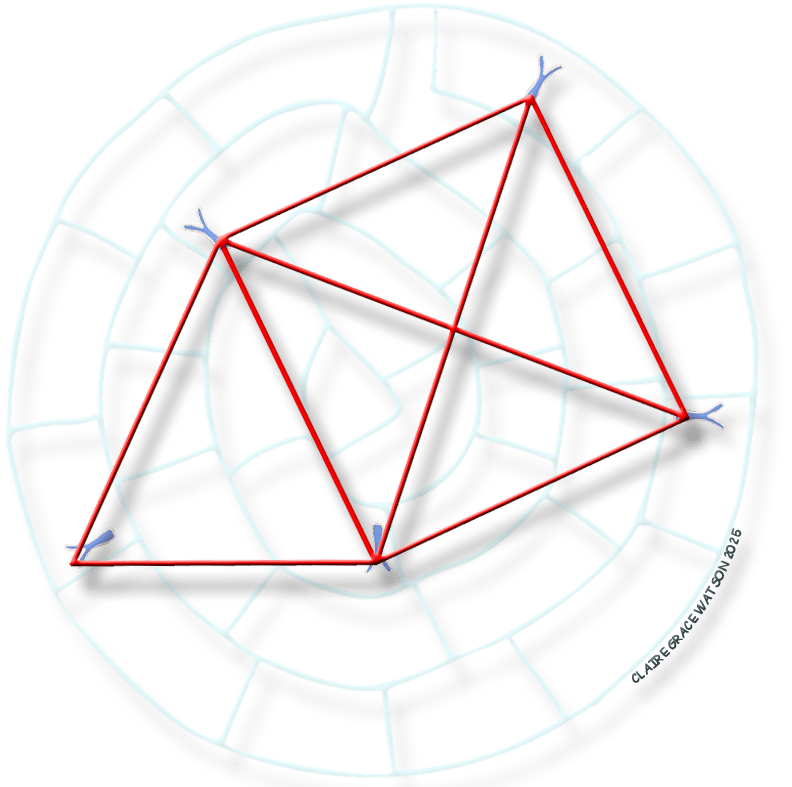
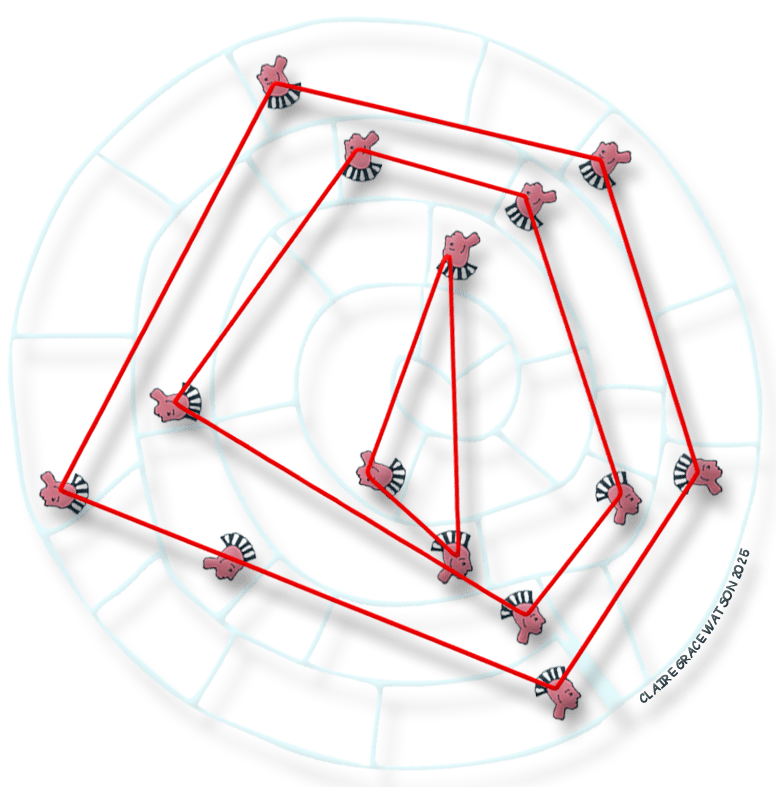
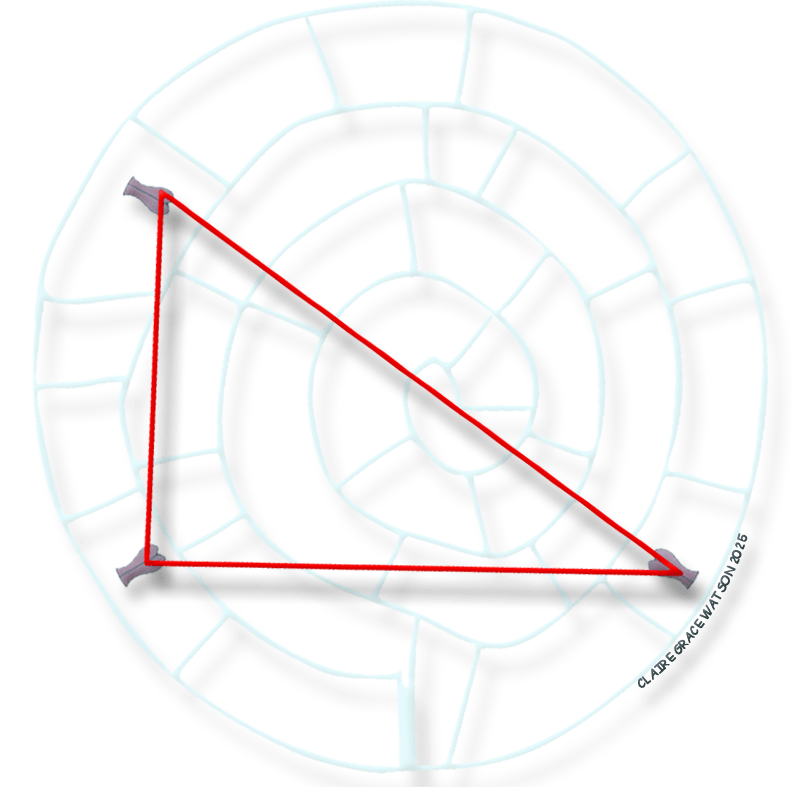
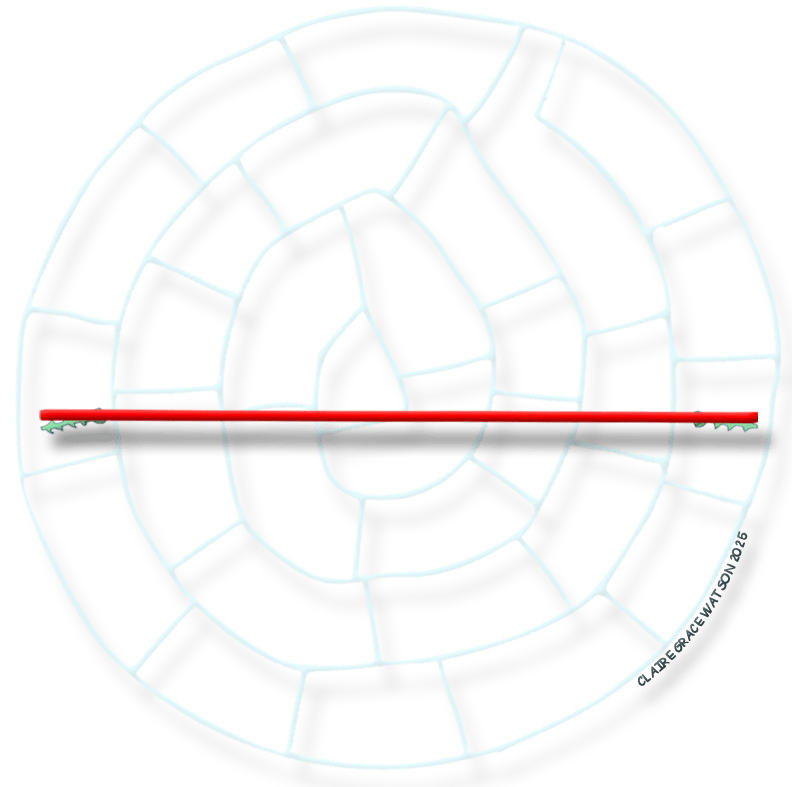 48 Unique Phaistos Disk Pictographs
48 Unique Phaistos Disk Pictographs
 Picture Writing
Picture Writing
 Continuous Representation
Continuous Representation
Narrative Art Phaistos Disk pictographs color-coded
Phaistos Disk pictographs color-coded If now we try to restore this buried culture from the relics that remain -- playing Cuvier to the scattered bones of Crete -- let us remember that we are engaging upon a hazardous kind of historical television, in which imagination must supply the living continuity in the gaps of static and fragmentary material artificially moving but long since dead. Crete will remain inwardly unknown until its secretive tablets find their Champollion.
If now we try to restore this buried culture from the relics that remain -- playing Cuvier to the scattered bones of Crete -- let us remember that we are engaging upon a hazardous kind of historical television, in which imagination must supply the living continuity in the gaps of static and fragmentary material artificially moving but long since dead. Crete will remain inwardly unknown until its secretive tablets find their Champollion.
 For further research and investigation into the Disk and its cosmic significance, I highly recommend Watson's work. I believe that her insights into this enigmatic artifact will, in time, prove to be the most accurate. (Peter Sterling, Harp Magic)
For further research and investigation into the Disk and its cosmic significance, I highly recommend Watson's work. I believe that her insights into this enigmatic artifact will, in time, prove to be the most accurate. (Peter Sterling, Harp Magic)
It has been discovered that connecting similar signs arranged in concentric circles on an enigmatic artefact known as the "Disk of Phaistos" enables a hidden geometry to emerge...It seems to show signs amounting to a language but if it is a language no one has found a way to decipher it...
 However, Claire Grace Watson has argued very cogently that these signs are ideograms not hieroglyphs -- so perhaps this disk is in itself a maze. Her practice of connecting similar signs on the disk with each other, as in a drawing puzzle where you join the dots, has generated startling results. Geometrical shapes are readily generated. The disk employs a geometry of alignment that goes beyond number and a set-square. Hers is an ingenious solution to a long-standing enigma, and it reinforces the notion that the ingenuity of the Cretans was valued in Egypt and throughout that fertile zone of the ancient world.
However, Claire Grace Watson has argued very cogently that these signs are ideograms not hieroglyphs -- so perhaps this disk is in itself a maze. Her practice of connecting similar signs on the disk with each other, as in a drawing puzzle where you join the dots, has generated startling results. Geometrical shapes are readily generated. The disk employs a geometry of alignment that goes beyond number and a set-square. Hers is an ingenious solution to a long-standing enigma, and it reinforces the notion that the ingenuity of the Cretans was valued in Egypt and throughout that fertile zone of the ancient world.
I had wondered before why the spiral was sort of uneven, when obviously there are a lot of "perfect" spirals in the Minoan art, but of course if the spiral was "perfect" then the patterns for the constellations and geometric shapes would not be accurate. So it makes the artistry involved in creating the Disk even more impressive!  "I just wanted to tell you that I am very impressed by the astronomical and mathematical patterns you found on the Disk. I feel that the patterns you found are too many and too accurate to be mere coincidence, and joining the matching symbols is such a simple and elegant solution! I am very surprised that no-one else has noticed these patterns before!"
"I just wanted to tell you that I am very impressed by the astronomical and mathematical patterns you found on the Disk. I feel that the patterns you found are too many and too accurate to be mere coincidence, and joining the matching symbols is such a simple and elegant solution! I am very surprised that no-one else has noticed these patterns before!"
 "I am very impressed with your achievement and I strongly believe that you deserve complete recognition both in Greece and abroad for your profound revelation. (Nick Kallianiotis)
"I am very impressed with your achievement and I strongly believe that you deserve complete recognition both in Greece and abroad for your profound revelation. (Nick Kallianiotis)
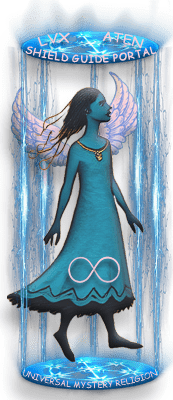 Copyright Notice - Disk of the World - Text and images copyrighted March 21, 1993-2025, Claire Grace Watson, B.A., M.S.T., U.S. Copyright and under the Digital Millennium Copyright Act of 1998, All rights reserved. No part of this web page may be reproduced or transmitted in any form or by any means without written permission from the author, except for the inclusion of brief quotations in a review.
Copyright Notice - Disk of the World - Text and images copyrighted March 21, 1993-2025, Claire Grace Watson, B.A., M.S.T., U.S. Copyright and under the Digital Millennium Copyright Act of 1998, All rights reserved. No part of this web page may be reproduced or transmitted in any form or by any means without written permission from the author, except for the inclusion of brief quotations in a review.